Table Window
The Table window is a table representation of the relational
data accessed in the creation of a Dimension; it shows the structure of
the table, its columns and data. In the image below, the top half of the
screen displays the columns and data; the bottom half of the window shows
the multidimensional Dimensions built from the relational table.
 Notes
Notes

This is what a 'Dimension Editing Window' for relational-based
Dimensions look like. And as such, this window is also refereed to as
Dimension Editing Window across the help.
Three main parts of the Table window:
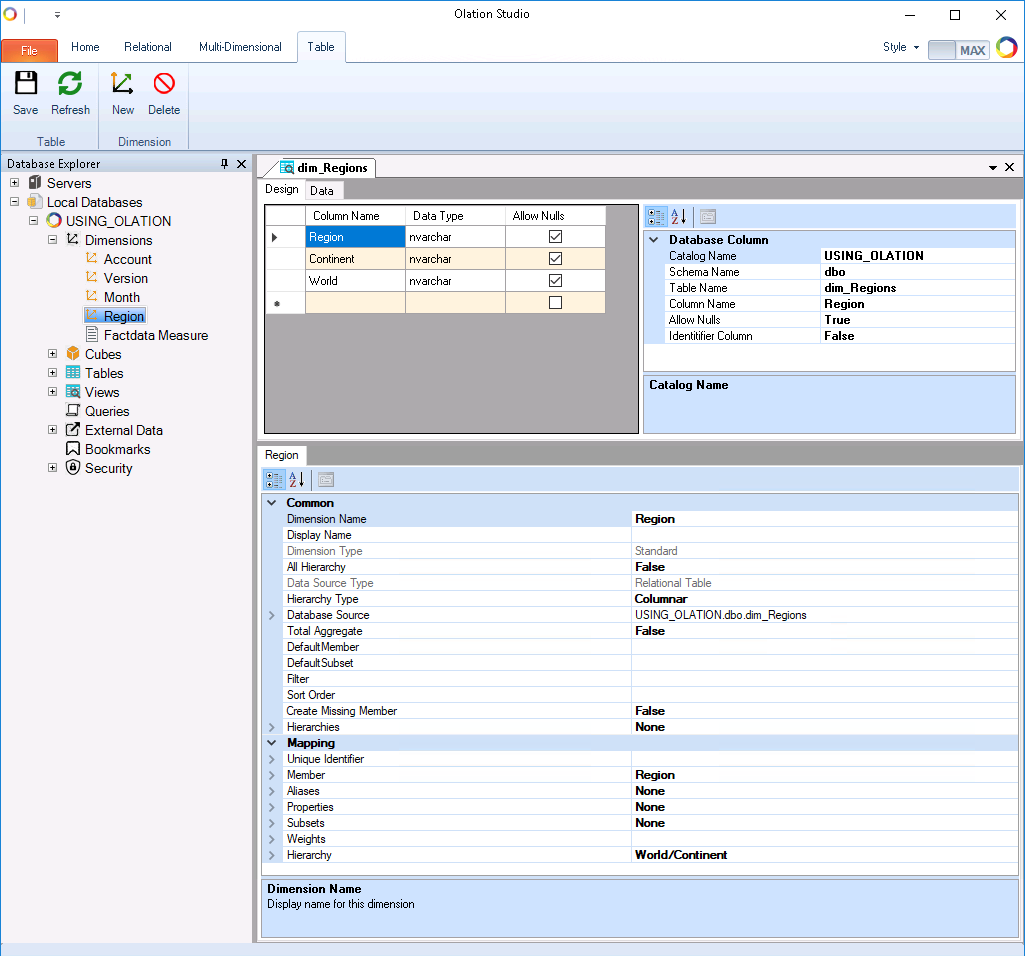
Table Window Command Icons
The Table Tab, which becomes
available on the OLATION ribbon when accessing the Table window, includes
the following commands:
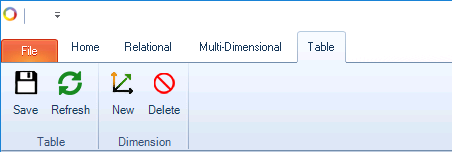
Icon
Name |
Icon |
Function |
Save
Table |

|
Saves
a newly created or modified Dimension and any defined attributes. |
Refresh Table |

|
Refreshes
or updates data from the relational source. |
New Dimension |

|
Creates
a new Dimension out of the currently opened or active relational
component, such as tables, views and query. |
Delete Dimension |

|
Deletes
the currently opened Dimension. |
DESIGN Tab
The Design Tab contains information about the
columns that exist in the source relational table. This tab has a structure
similar to the Design mode of SQL tables. The left-hand pane provides
a list of all existing column names or fields, their respective Data Types,
and whether the Allow Nulls option is enabled for each column.
The right-hand pane details the column properties of the selected column.
When creating a Dimension out of relational tables, this Design tab can
also be used to define Dimension attributes.
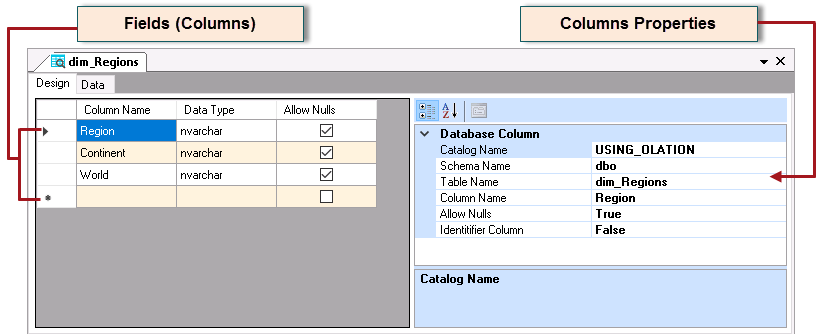
DATA Tab
The Data Tab displays the records contained in
the relational table. Records can be added or modified through the Data
window.
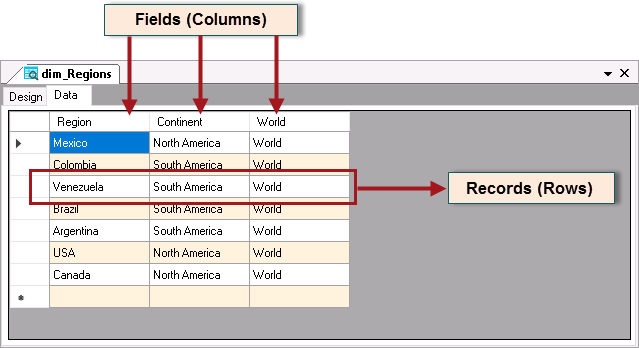
PROPERTY
GRID
The Property Grid displays information about the
Dimension(s) that have been created out of a particular relational table,
as well as the additional attributes that have been configured for the
Dimension(s). When a Dimension is created from a relational table, this
Property Grid appears at the bottom of the Table window. If multiple Dimensions
have been created out of a single table, the grid appears having multiple
tabs, each bearing a header corresponding to the Dimension names.
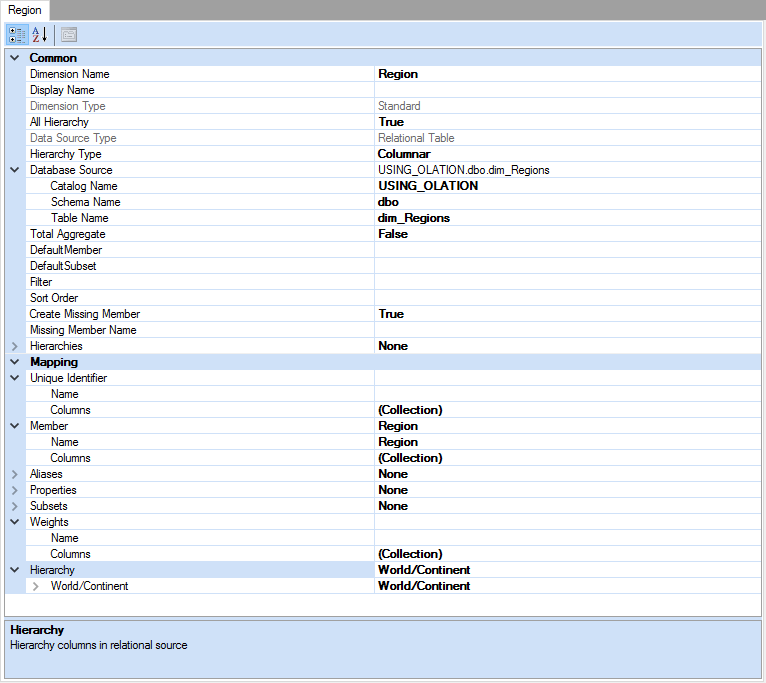
Settings found in this Window:
COMMON:
- Dimension
Name – Displays the
name of the Dimension. Rename the Dimensions by typing a new name
in the corresponding field.

- Display
Name – The editable
display name for the Dimension that will show in a Slice.

- Dimension
Type– Displays the Dimension
type of the selected Dimension.
 –
Allows a user to create a Total Aggregate at the top of the hierarchy
that sums up all detail elements.
–
Allows a user to create a Total Aggregate at the top of the hierarchy
that sums up all detail elements.
- All
Hierarchy– Enable this option
to create an “All” Member that is a hierarchy/aggregation of all Detail
Members.
 –
Enable this option to create an “All” Member that is a hierarchy/aggregation
of all Detail Members.
–
Enable this option to create an “All” Member that is a hierarchy/aggregation
of all Detail Members.
- Data
Source Type– Displays the
type of data source the relational data is coming from.
 –
Displays the type of data source the relational data is coming from.
–
Displays the type of data source the relational data is coming from.
- Hierarchy
Type– Indicates Hierarchy
Type, whether Columnar or Parent-Child.
 –
Allows a user to create a Total Aggregate at the top of the hierarchy
that sums up all detail elements.
–
Allows a user to create a Total Aggregate at the top of the hierarchy
that sums up all detail elements.
- Database
Source Type–
Relational database and table that is the dimensional logic is coming
from.
 –
Relational database and table that is the dimensional logic is coming
from.
–
Relational database and table that is the dimensional logic is coming
from.
- Total
Aggregate – Enable this option
(True) to create a Total aggregate Member for defined Hierarchies.

- Default
Member– This is the Member
that will appear by default in a report/Slice (PowerExcel, PowerOLAP,
etc.) when the Dimension is determined by the Filter function in a
newly created Slice. The Default Member name must be typed in.

- Default
Subset– These are the Members
that will appear by default in a report/Slice (PowerExcel, PowerOLAP,
etc.) in a Row or Column if the Dimension is oriented in a newly created
Slice. The Default Subset name must be typed in.

- Filter –
Allows a user to return or include only a specific set of members
for the Dimension they are creating. This is similar to the concept
of conditional retrieval.

- Sort
Order– Allows a user to define
the order of Members in a Dimension via the consequent Sort Order
Window.

- Create
Missing Member– Allows a user to create
a default Member into which all missing values are inserted.

- Missing
Member Name– Name of Member for
missing values—becomes active when (f) is made True.

- Hierarchies–
Allows a user to create a Total Aggregate at the top of the hierarchy
that sums up all detail elements.
 –
Allows a user to create a Total Aggregate at the top of the hierarchy
that sums up all detail elements.
–
Allows a user to create a Total Aggregate at the top of the hierarchy
that sums up all detail elements.
MAPPING:
- Unique
Identifier– Allows a user to specify
which columns to set as the unique identifier.

- Member–
Allows a user to specify which columns to set as Dimension member.
If multiple columns are selected, those columns are concatenated together
into the Dimension name.

- Aliases–
Allows a user to specify which columns represent an Alias.

- Properties–
Allows a user to specify which columns represent Properties.

- Subsets–
Allows a user to create a Subset based on data in selected column.

- Weights–
Allows a user to specify Weighting columns in a relational source.

- Hierarchy–
Allows a user to define the Hierarchy structure of a Dimension.

Right-click Menu Options found in Table Window
Shown below are the 'Righ-click Menu options' that can
be found in the Table window.
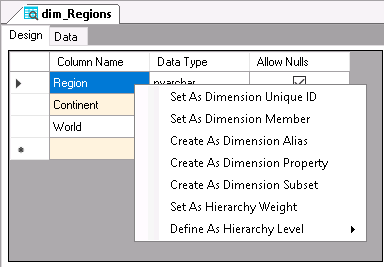 |
Command |
Function/Description |
Set As
Dimension Unique ID |
Enables
you to set selected column as the Unique Identifier. |
Set As
Dimension Member |
Enables
you to select the column from which Dimension Members
will be created from. |
Create
As Dimension Alias |
Enables
you to create Dimension Aliases out of existing columns. |
Create
As Dimension Property |
Enables
you to create Dimension Properties out of existing columns. |
Create
As Dimension Subset |
Enables
you to create Subsets out of existing columns. |
Set As
Hierarchy Weight |
Enables
you to set a Dimension's Hierarchy weight based on a column
where the aggregate weight of corresponding Members are
defined. |
Define
As Hierarchy Level |
Enables
you to define a Dimension's Hierarchy structure by allowing
you to set columns as the root parent and sub-level parents. |
|
 |
Command |
Function/Description |
New Dimension |
Enables
you to create a new Dimension based on the currently opened
source table. When this is selected, this will bring up
the Create New Dimension dialog box. |
|
![]() Notes
Notes![]()




